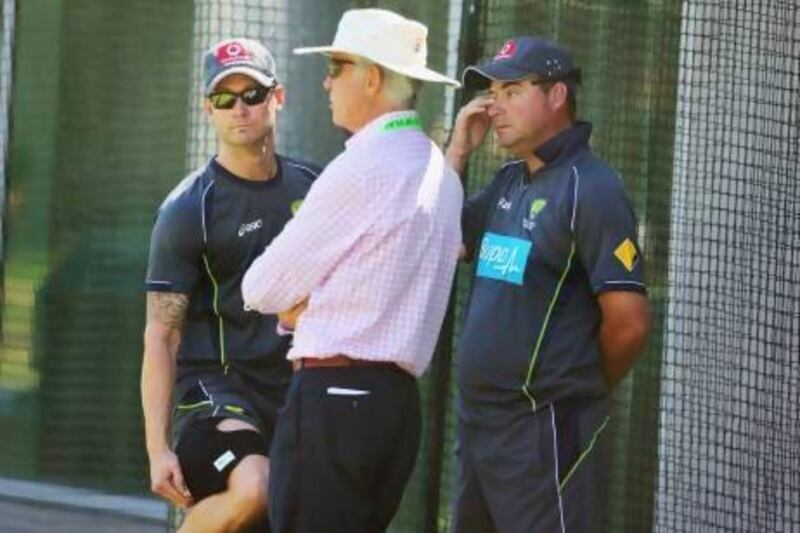Mickey Arthur, Australia's current coach, was less than two years old the last time the team lost all four matches in a series, in 1970.
Shane Watson, who led them in the Delhi Test, was even smaller when Australia were last whitewashed, 3-0 in Pakistan in 1982/83.
This 4-0 drubbing, against an India side that lost by the same margin in Australia less than 14 months ago, will probably hurt far more.
The 1970 South Africans were a great side, though that 4-0 win would be the last that the world saw of them for more than two decades.
Superbly led by Ali Bacher, they had enormous strengths and few weaknesses. Graeme Pollock and Barry Richards both made more than 500 runs in the series, while Mike Proctor (26 wickets) and Peter Pollock (15) destroyed Australia with pace bowling of the highest quality. And then there was great Eddie Barlow, who made 360 runs and took 11 wickets at 23.
Australia, exhausted after a hard slog around India – they had won a five-Test series 3-1 – were simply no match for them.
Their gun batsman, Ian Chappell, finished with 92 runs, while Graham McKenzie, their finest bowler, took one wicket for 333.
In Pakistan 12 years later, a side manifestly superior with bat and ball thrashed them. Zaheer Abbas and Mohsin Khan were in prime form with the bat, while Imran Khan and Abdul Qadir ensured that pace and spin were equally devastating.
Neither of those defeats was unexpected. The South Africans would have beaten most sides of that era in their own backyard, while Pakistan were so formidable on home soil that even the legendary West Indies sides won only one series there.
The situation before this Indian tour was very different.
Australia may have lost the experience of Ricky Ponting and Michael Hussey – the second far more unexpected than the first – but they were taking on a team that had just lost to England at home for the first time in nearly three decades.
Apart from the first Test against England, there had not been an Indian win against quality opposition since Durban in December 2010.
Not one of the four Tests went the full five days, and at no stage did it seem that Australia were in with a strong chance of winning one.
Michael Clarke scored Australia's only hundred of the series, on the opening day in Chennai. Of the others, only Ed Cowan crossed 200 runs, but an average of 33 and strike-rate of 37 are not going to intimidate any fielding side.
Nathan Lyon finished with 15 wickets, including nine in Delhi, despite being dropped for the second Test in Hyderabad. No one else reached double figures. James Pattinson, the most impressive of the pace pack, bowled just 79 overs in the three games he played.
With two Ashes series to be played over the next 10 months, it is hard to see how Arthur and Clarke can bring about any drastic improvements.
An end to new-fangled notions of selection would be a start though. In the old days, Australia usually picked their 11 best cricketers and made one of them captain. Now, you see one-day specialists in Test whites, and a disjointed horses-for-courses policy. If Steven Smith and Glenn Maxwell are Australia's Test stars of the future, then the larder really is bare.
A cursory look at this season's Australian first-class statistics suggests as much.
Ponting, Hussey and Clarke all made three hundreds. The only other man to do so, Chris Rogers, made his only Test appearance against India in Perth more than five years ago. Tasmania's Alex Doolan is the only one on the fringes to average more than 50.
Maybe the selectors know something about Smith and Maxwell that we do not. Perhaps they are attempting to emulate what India did to such startling success with Ravindra Jadeja.
Initially picked as an all-rounder, Jadeja's haul of 24 wickets was second only to Ravichandran Ashwin's. He also contributed a bustling 43 at a vital time in the Delhi Test.
But Jadeja, despite the widespread mocking of his ability on social media and elsewhere, had formidable first-class figures to back his Test claims. Neither Smith nor Maxwell does.
The same is true of Joe Burns and Nic Maddinson, promising players whose numbers point to a worrying lack of consistency.
Australia could do worse than to give a chance to George Bailey, who has acquitted himself with aplomb in the one-day international arena, averaging 44.94 after 21 games. He also has 14 first-class hundreds and is on the verge of leading Tasmania to Sheffield Shield glory.
Five weeks ago, most were pondering India's problems with transition. But after MS Dhoni's decisive double-century in Chennai, more than 400 runs for both Murali Vijay and Cheteshwar Pujara, and 29 wickets for Ashwin, the future is no longer something that terrifies fans.
With most of India's Test cricket to be played away from home over the next two years though, there is no room whatsoever for complacency.
Follow us
[ @SprtNationalUAE ]





